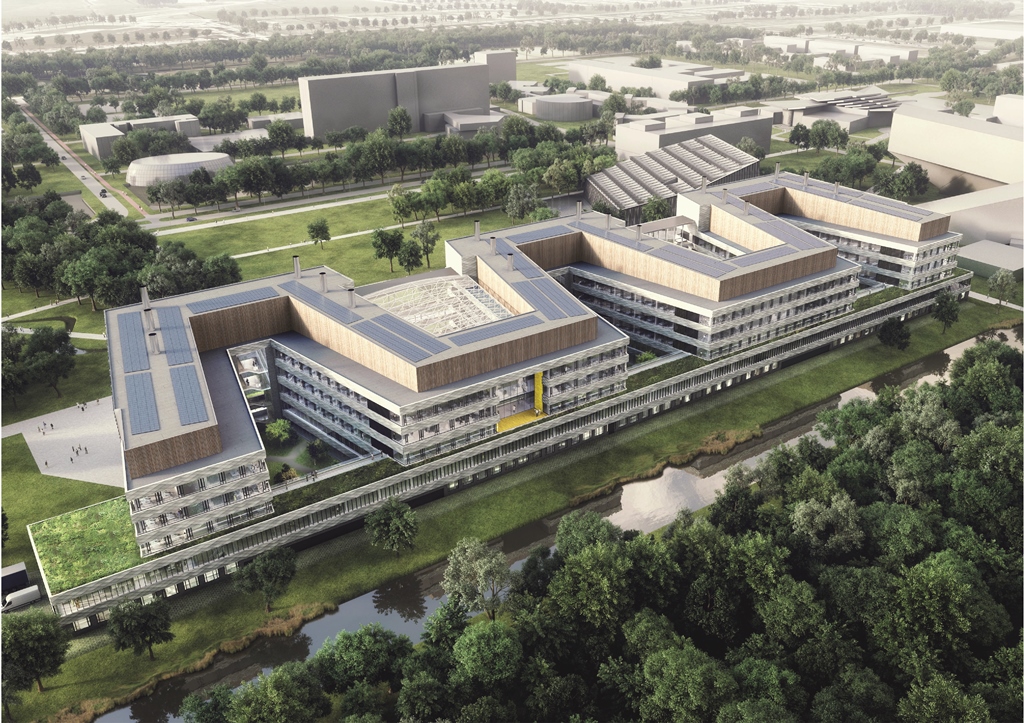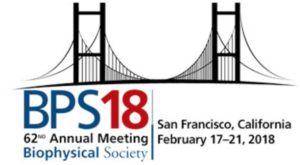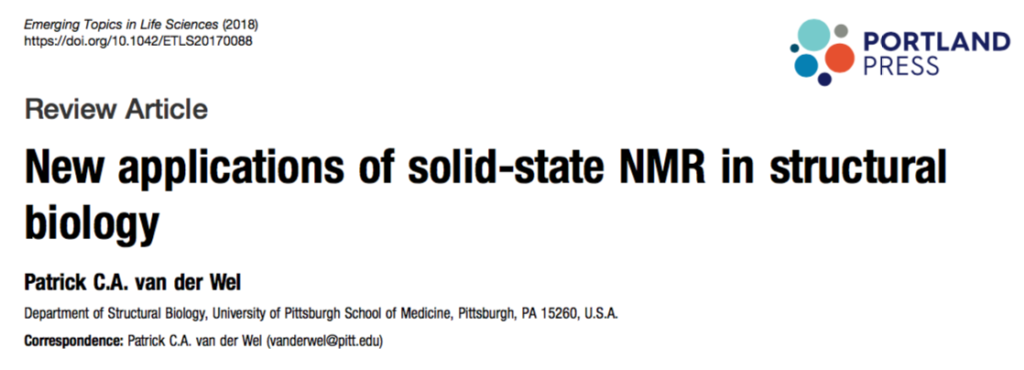Author: Patrick
Update on New Feringa Building
Exciting news about the upcoming construction of a brand new building for the lab and the Institute. Construction of the new Feringa Building at the RUG will commence later this year, to be completed in 2021. For more see link:
https://www.rug.nl/groundbreakingwork/190222_feringa_building_construction_agreement

Looking for NMR research technician (MSc/PhD)
More information to follow later, but we just posted the official advertisement for a new research technician with a NMR/SSNMR background. For details see here:
https://www.rug.nl/about-us/work-with-us/job-opportunities/overview?details=00347-02S0006SAP
The deadline is Feb 14th, 2019. Applications should be done via the above URL.
Publication: new collaborative paper on DNP/ssNMR-enabled studies at natural abundance (JACS).
Congrats to Talia, Jennifer and Irina, as well as our international network of collaborators on the acceptance of an exciting new paper in JACS. It describes the power of dynamic nuclear polarization (DNP) to enable multidimensional solid-state NMR studies of polyglutamine-expanded huntingtin exon 1 fibrils. Importantly in these experiments we did not apply stable-isotope labeling to these protein deposits that are implicated in Huntington’s disease. This approach enables great structural data and can hopefully prove applicable to many more (types of) samples.
More info to follow, but for now: Read the accepted paper here at the journal.
Title: Structural fingerprinting of protein aggregates by DNP-enhanced solid-state NMR at natural isotopic abundance
Authors: Adam N. Smith, Katharina Märker, Talia Piretra, Jennifer C. Boatz, Irina Matlahov, Ravindra B. Kodali, Sabine Hediger, Patrick C.A. van der Wel, and Gaël De Paëpe
DOI: 10.1021/jacs.8b09002
New PhD position(s) available in Groningen.
Please visit the “Join?” page for information about new PhD position(s) opening up in the lab at the University of Groningen. Or:
University of Groningen, the Netherlands
Starting in Aug. 2018, the solid-state NMR group of Prof. Van der Wel has moved to the Zernike Institute for Advanced Materials at the University of Groningen. This brings Prof. Van der Wel back to the Netherlands after many years in the USA.
Please also see the announcement here: https://www.rug.nl/research/zernike/news/newsitems/201808_vdwel
We look forward to continuing our interdisciplinary collaborative research with new and old collaborators across the globe. For a while the group will be in transition. Please stay posted for further news, updates and exciting new papers.
Selected Links:
- ZIAM announcement
- ZIAM homepage
- University of Groningen homepage
- Groningen, The Netherlands on wikipedia
Publication: Dynamics-based spectral editing – DYSE SSNMR.
Our new review article discussing the concept of dynamics-based spectral editing (DYSE) in ssNMR is now available online in the journal Methods. In it, we describe how the dynamics-sensitive pulse sequences enable the filtering out (or spectral editing) of signals based on their differences in dynamics. Applications by ourselves and many other groups are discussed. Notably, these applications range across a huge swatch of different sample types, going from designer peptide nano materials to whole tissues and even living organisms.
Citation:
- Hidden motions and motion-induced invisibility: dynamics-based spectral editing in solid-state NMR. Matlahov, I., Van der Wel, P.C.A. Methods, in press [URL]
Publication: New applications of solid-state NMR in structural biology. (review)
Our new paper discussing the role of modern solid-state NMR in integrated structural biology is now published in Emerging Topics in Life Sciences. It provides a review of a selection of recent solid-state NMR studies from (mostly) the last decade. Not only does it give a review of notable 3D structures obtained by solid-state NMR, but it also examines contributions going beyond static protein structures. This includes the characterization of biologically relevant dynamics, and the pinpointing of crucial intermolecular interactions.
Reference:
- Patrick C.A. van der Wel (2018) “New applications of solid-state NMR in structural biology.” Emerging Topics in Life Sciences, Vol. 2, pp. 57–67
Access:
- DOI: 10.1042/ETLS20170088
- Request reprints by email: vanderwel@pitt.edu.
- Open Access PDF for download: OA PDF
Van der Wel lab at the Biophysical Society Meeting in San Francisco!
This coming week the Van der Wel lab will be represented at the annual meeting of the Biophysical Society, taking place in San Francisco. As summarized below, a recurring theme in the presented work will be the impact of oxidative damage in health and disease.

Dr. Mingyue Li will present her studies of mitochondrial protein-lipid interactions during her platform session talk on Monday Feb. 19 (1130AM; 999-PLAT). She will talk about the structure and dynamics of the cardiolipin-cytochrome c complex that is implicated in the early stages of mitochondrial apoptosis. This protein/lipid complex features a peripherally bound protein that facilitates the oxidation of poly-unsaturated cardiolipin lipids.
Jennifer Boatz will present a poster on Feb 21st (2815-Pos; B23) on her use of magic-angle-spinning NMR and electron microscopy to probe the aggregated state of apolipoprotein A1, in presence and absence of methionine oxidation. Aggregated ApoA1 is a prominent component of deposits formed during atherosclerosis. For more information see Jennifer’s poster and our in-press collaborative publication in the FASEB Journal.
Publication: Amyloid seeding by oxidized apolipoprotein A-I
Congratulations to collaborator Giorgio Cavigiolio, his group at CHORI (Children’s Hospital Oakland Research Institute), and Jennifer Boatz on the publication of our new collaborative paper. It reports functional and structural studies of the effect of oxidation on apolipoprotein A-I (ApoA1), using a variety of experiments and assays – including solid-state NMR. Oxidation of the protein causes it to become more monomeric and also less stably folded. As a consequence it becomes prone to aggregation into amyloid-like fibrils. Interestingly, these oxidized aggregates are able to subvert non-oxidized protein into an amyloidogenic (i.e. aggregation-prone) state. Another interesting aspect of these aggregated proteins is that they may feature a typical amyloid core structure composed of β-sheets, but that large parts of the protein stay outside this core structure. These latter “flanking”domains retain much of their native α-helical fold, somewhat reminiscent of our prior findings in the Huntington’s disease protein. We hypothesize that these non-amyloid domains may mediate interactions not only within the fibrils but also between fibrils and still-soluble native proteins. The paper also discusses the potential role of these molecular processes in atherosclerosis.
The paper:
Andrzej Witkowski, Gary K. L. Chan, Jennifer C. Boatz, Nancy J. Li, Ayuka P. Inoue, Jaclyn C. Wong, Patrick C. A. van der Wel, and Giorgio Cavigiolio (2018) “Methionine oxidized apolipoprotein A-I at the crossroads of HDL biogenesis and amyloid formation” FASEB Journal, in press. Online at the journal, and also on PubMed.
Publication: Molecular underpinnings of amyloid fibril twisting.
Congratulations to our collaborators for the new collaborative paper on the characteristic twisting of amyloid fibril filaments, which has just appeared online as accepted for publication in the Journal of Physical Chemistry B. The paper, titled “Energetics Underlying Twist Polymorphisms in Amyloid Fibrils“, describes molecular dynamics simulations of the twisting of amyloid-like structures of the GNNQQNY peptide fragment from the yeast prion protein Sup35p. This particular peptide has developed into an essential model system for studies of the structure and formation of amyloid fibrils, and (for instance) how they differ from crystalline assemblies formed by these and other polypeptides [1-3].
The full citation is:
Energetics Underlying Twist Polymorphisms in Amyloid Fibrils.
Periole, X., Huber, T., Bonito-Oliva, A., Aberg, K.C., Van der Wel, P.C.A., Sakmar, T.P., & Marrink, S.J. (2018) J. Phys. Chem. B 122 (3), pp 1081–1091
Accessible online at the journal.
Related references:
[1] Nelson et al. (2005) Nature 435(7043): 773-778
[2] Van der Wel et al. (2007) J Am Chem Soc 129(16): 5117-5130
[3] Van der Wel et al. (2010) Biochemistry 49(44): 9457-9469
